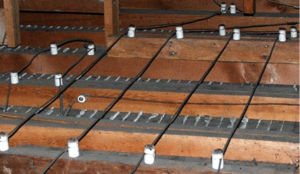Knob-and-tube wiring (K&T) is an early standardized method of electrical wiring that you may see in homes built from the 1880s to 1930s. Currently, the United States National Electrical Code forbids the use of loose, blown-in, or expanding foam insulation over K&T wiring in most states. This is because K&T is designed to let heat dissipate to the surrounding air. As a result, energy efficiency upgrades that involve insulating previously uninsulated walls usually also require the replacement of the wiring.
Other reasons K&T can be dangerous besides its age are the lack of ground wiring making it incompatible with your modern-day three-prong outlets. Also, they are not able to be used in moist environments, such as bathrooms and kitchens. If used in a wet environment this can create a dangerous space by creating a flammable scenario if an outlet becomes wet. To create a safer environment it is recommended that these be replaced within your home.
How to Spot Knob-and-Tube Wiring
It consists of single-insulated copper conductors run within wall or ceiling cavities, passing through joist and stud drill-holes via protective porcelain insulating tubes, and supported along their length on nailed-down porcelain knob insulators. Where conductors entered a wiring device such as a lamp or switch or were pulled into a wall, they were protected by flexible cloth insulating sleeving called the loom. The first insulation was asphalt-saturated cotton cloth, then rubber became common.


